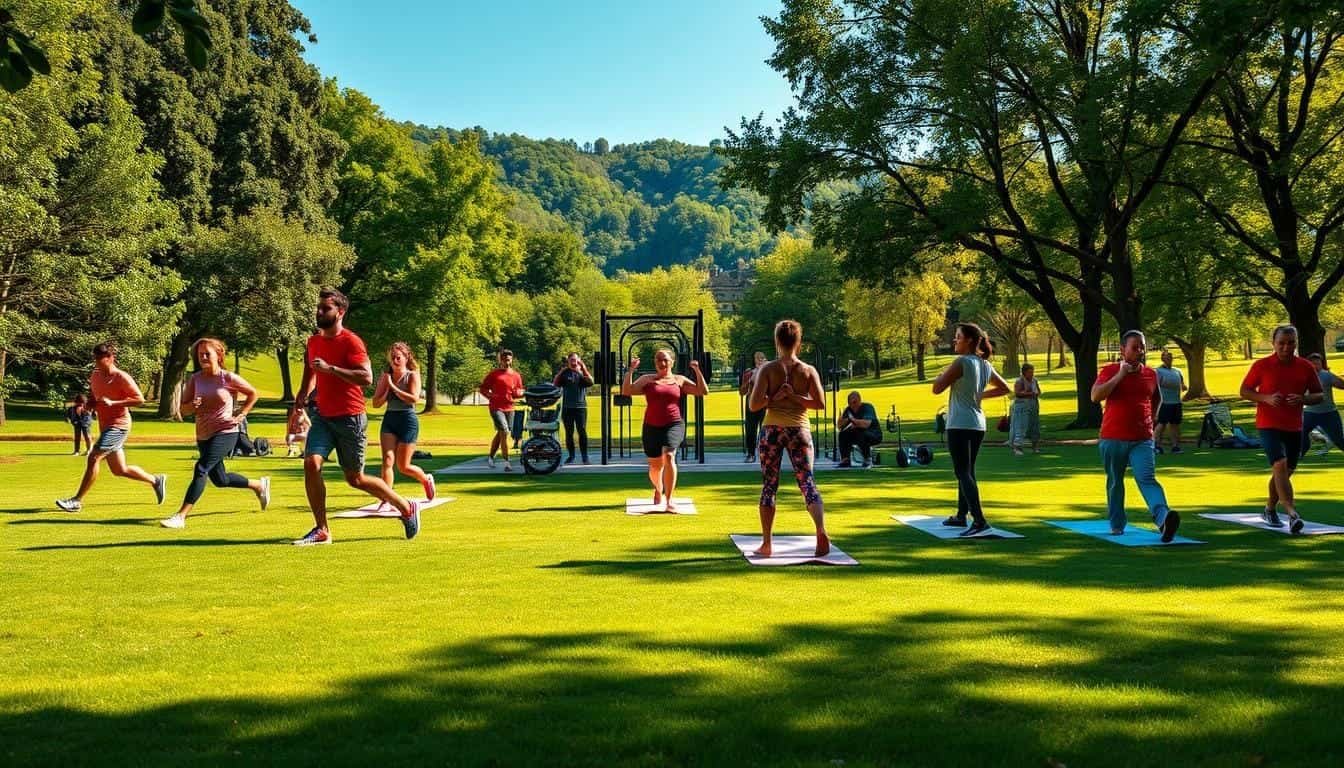Have you ever felt like improving your well-being but weren’t sure where to start? Physical activity is a simple yet powerful first step. Even small bouts of movement can make a big difference in how you feel and your overall health.
If you’ve ever wondered what are the healthy lifestyle activities that can truly make an impact, the answer may be simpler than you think. Research shows that regular exercise helps reduce the risk of chronic diseases, improves sleep, and boosts mood. It’s not about intense workouts; even short walks or light stretches count. The key is to find activities you enjoy and can stick with.
In this guide, we’ll explore various exercise routines, safety tips, and personalized approaches to help you build healthy habits. Our goal is to make it easy for you to enhance your quality of life through simple, sustainable changes.
Key Takeaways
- Short bursts of physical activity can improve overall well-being.
- Regular exercise reduces the risk of chronic diseases and enhances mood.
- Simple actions, like walking, can be effective for improving health.
- Find activities you enjoy to make exercise a sustainable habit.
- This guide offers tailored approaches to boost your quality life.
Understanding Healthy Lifestyle Activities
Engaging in regular physical activity is a cornerstone of a balanced life. It not only enhances our overall well-being but also plays a vital role in preventing chronic diseases. By incorporating even small amounts of movement into our day, we can experience significant improvements in both physical and mental health.
Defining Healthy Living
Healthy living is more than just exercise; it’s about making conscious choices that support our bodies and minds. Regular physical activity is a key component, helping to build muscle strength, improve heart health, and boost energy levels. Even a little extra time spent moving each day can make a big difference in how we feel and function.
Key Benefits of Regular Activity
The benefits of regular activity are numerous. For one, it lowers the risk of heart disease and improves sleep patterns. Additionally, staying active can enhance our mood and reduce stress. Consistency is key; every person can benefit from a small daily investment in their health.
| Activity Type | Recommended Duration | Key Benefits |
|---|---|---|
| Moderate-Intensity Aerobic | 150 minutes/week | Improves cardiovascular health, boosts mood |
| Vigorous-Intensity Aerobic | 75 minutes/week | Increases calorie burn, enhances endurance |
| Muscle-Strengthening | 2 days/week | Builds muscle, improves bone density |
As shown in the table, a mix of moderate and vigorous activities, along with strength training, provides a well-rounded fitness routine. Remember, every bit of movement counts, and even short bursts can add up to make a significant impact on our health and quality of life.
Deep Dive: what are the healthy lifestyle activities
Discovering the right mix of physical activities can transform your life. For adults, finding enjoyable exercises is key to maintaining consistency.
Exploring Various Activity Types
Walking is an excellent starting point, especially for adults new to exercise. It’s low-impact and easily fits into a daily routine. Brisk walking, for instance, falls under moderate-intensity aerobic activity, which is recommended for at least 150 minutes each week.
Intensity levels vary, with moderate activities like swimming or biking and vigorous ones like running. Understanding these types helps tailor routines to personal fitness levels, making workouts more effective.
| Activity Type | Recommended Duration | Key Benefits |
|---|---|---|
| Brisk Walking | 150 minutes/week | Improves heart health, boosts mood |
| Running | 75 minutes/week | Enhances endurance, burns calories |
| Swimming | 150 minutes/week | Builds strength, low-impact |
Engaging in these activities reduces the risk of chronic diseases like heart disease and diabetes. Regular movement also improves mental health by lowering stress and anxiety levels. Tailoring your routine based on intensity and type ensures a balanced approach to improving health and overall well-being.
Designing Your Daily Exercise Routine
Creating a balanced exercise routine can seem overwhelming, but with the right approach, it becomes achievable. Consistency is key to seeing real benefits in our health and energy levels.
Incorporating Moderate and Vigorous Activities
Mixing moderate and vigorous activities keeps our workouts engaging. For example, cycling or running can add variety while maintaining progress. Remember, 10 minutes of vigorous activity equals about 20 minutes of moderate effort.
Aim for at least 150 minutes of moderate aerobic exercise each week. If you prefer vigorous activities, 75 minutes a week is enough. For extra benefits, you can gradually increase to 300 minutes of moderate or 150 minutes of vigorous exercise.
Guidelines for Strength and Flexibility Training
Strength training is essential for muscle and bone health. Aim for two sessions a week, focusing on all major muscle groups. Use weights or resistance that challenge your muscles after 12-15 reps. Rest for 48 hours between sessions to allow recovery.
Incorporate flexibility exercises at least twice a week, ideally after workouts. Hold stretches for 20-30 seconds and repeat 3-4 times for best results. Balance exercises like yoga or tai chi can also enhance stability and reduce injury risk.
| Activity Type | Recommended Duration | Key Benefits |
|---|---|---|
| Moderate Aerobic | 150 minutes/week | Improves heart health, boosts mood |
| Vigorous Aerobic | 75 minutes/week | Enhances endurance, burns calories |
| Strength Training | 2 days/week | Builds muscle, improves bone density |
Each minute counts, and even small increases can make a big difference. Start with short sessions and gradually build up. Celebrate each workout as a step toward better health and well-being.
Leveraging Physical Therapy and Safe Practices
When it comes to building a safe and effective exercise routine, physical therapy offers valuable insights. Whether you’re recovering from an injury or managing a specific condition, consulting with a physical therapist can provide personalized recommendations tailored to your needs.
Consulting Our Physical Therapist
A physical therapist can help you design a fitness plan that protects your body while improving overall fitness. For example, if you have a condition like joint pain, they might recommend low-impact activities such as swimming or cycling. These exercises are gentle on the bones and joints, making them ideal for long-term health.
- Physical therapists emphasize safe practices to prevent injuries and promote healing.
- They often suggest activities like biking or gentle stretching to support bone health.
- Customized routines help address specific conditions, ensuring exercises are both effective and safe.
By working with a physical therapist, you can create a balanced routine that supports your body’s needs. This approach not only enhances fitness but also safeguards your overall well-being, making it easier to maintain a consistent and enjoyable exercise habit.

Maximizing Health Benefits Through Variety
Adding variety to your exercise routine is key to maximizing health benefits. Mixing cardio, strength, and flexibility exercises ensures a well-rounded approach to fitness. This not only keeps your workouts engaging but also reduces the risk of overuse injuries and prevents boredom.
Balancing Cardio, Strength, and Flexibility
Cardio exercises, like brisk walking or cycling, improve heart health and boost mood. Strength training, such as weight lifting, builds muscle and enhances bone density. Flexibility exercises, like yoga, improve range of motion and reduce injury risk. Combining these elements creates a balanced routine.
Tips to Reduce Sedentary Time
Limiting sedentary behavior is crucial. Set reminders to move every hour and incorporate light activities into your day. Even small movements can make a difference in overall health.
| Activity Type | Recommended Duration | Key Benefits |
|---|---|---|
| Moderate-Intensity Aerobic | 150 minutes/week | Improves heart health, enhances mood |
| Vigorous-Intensity Aerobic | 75 minutes/week | Increases calorie burn, boosts endurance |
| Muscle-Strengthening | 2 days/week | Builds muscle, improves bone density |
Adapting Activities to Age and Ability
Physical activities should be tailored to suit different age groups and abilities to ensure safety and effectiveness. Whether you’re an adult or a child, finding the right balance is key to maintaining a consistent routine.
Customizing Routines for Adults and Kids
Adults and children have different needs when it comes to physical activities. For kids, playful exercises like cycling or swimming are ideal, promoting fun and development. Adults, especially those with injuries, should opt for low-impact activities like brisk walking or yoga to minimize strain.
| Age Group | Recommended Activities | Duration | Benefits |
|---|---|---|---|
| Children (6-12) | Cycling, Swimming, Dancing | 60 minutes/day | Improves coordination and overall fitness |
| Teenagers (13-18) | Running, Team Sports, Strength Training | 60-90 minutes/day | Builds muscle and enhances endurance |
| Adults (19-64) | Brisk Walking, Cycling, Yoga | 150 minutes/week | Supports heart health and flexibility |
| Seniors (65+) | Gentle Stretching, Tai Chi, Swimming | 30 minutes/day | Improves balance and reduces injury risk |
As shown in the table, activities should be scaled according to age and fitness level. For instance, a minute moderate of exercise can be adjusted to suit individual capabilities, ensuring safety and effectiveness. Cycling is a great example of an activity that can be enjoyed by all ages, with adjustments in intensity and duration.
“Tailoring your routine to your age and ability ensures long-term sustainability and reduces the risk of injury. It’s not about pushing limits but about making mindful choices that support overall well-being.”
Personalization is crucial. What works for a child may not suit an adult, and vice versa. By considering individual needs and abilities, everyone can create a routine that aligns with their current condition and goals. Remember, the key to success is consistency and enjoyment.

Staying Motivated in Our Healthy Lifestyle Journey
Maintaining motivation is a crucial part of any successful health journey. It’s easy to start strong, but keeping that momentum can be challenging. Let’s explore some practical strategies to help you stay on track and celebrate your progress along the way.
Setting Achievable Goals
Setting realistic goals is the first step toward staying motivated. Instead of aiming for drastic changes, focus on small, incremental steps. For example, if you’re just starting with training, begin with short daily walks and gradually increase your duration. Celebrate these small victories—they add up over time and help build strength and confidence.
Check This:
- How to Motivate Yourself to Workout After Work: Beat Fatigue and Stay Consistent
- How to Be More Motivated to WorkOut: Simple Habits to Stay on Track
Tracking Progress and Overcoming Setbacks
Consistency is key, but it’s important to be kind to yourself during setbacks. Use a journal or app to track your daily progress. This simple tip can help you stay accountable and motivated. Remember, every step forward, no matter how small, is a step in the right direction. If you miss a day, don’t let it discourage you—get back on track as soon as you can.
| Goal Type | Recommended Approach | Benefits |
|---|---|---|
| Daily Walks | Start with 10 minutes, gradually increase | Improves cardiovascular health, boosts mood |
| Strength Training | 2 sessions per week | Builds muscle, enhances bone density |
| Flexibility Exercises | 3 times a week after workouts | Reduces injury risk, improves mobility |
Remember, staying motivated is a journey, not a destination. By setting achievable goals, tracking your progress, and embracing support when needed, you can maintain a consistent and enjoyable routine. Lean on friends, family, or a community for help when you need it. Every small win brings you closer to your long-term goals.
Conclusion
Embracing a balanced life starts with small, consistent steps. The way we approach exercise and daily habits plays a significant role in our overall well-being. By making thoughtful choices, we can manage weight and reduce the risk of chronic diseases.
Every effort, no matter how small, contributes to better health. Whether it’s a short walk or a few minutes of stretching, these actions add up over time. Consistency is key to seeing lasting benefits.
Starting your journey today can lead to meaningful changes. Celebrate small victories and stay committed. Remember, the pursuit of a balanced life is both achievable and rewarding when approached with the right mindset. Let’s take the first step together toward a brighter, healthier future.
Source Links
- https://www.healthline.com/health/how-to-maintain-a-healthy-lifestyle – How to Maintain a Healthy Lifestyle: 12 Effective Tips
- https://www.calm.com/blog/healthy-habits – 13 healthy habits to start daily for a healthier lifestyle — Calm Blog

